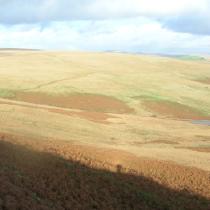 Construction of the Mynydd y Gwair onshore wind farm in South Wales started in January 2017.
Construction of the Mynydd y Gwair onshore wind farm in South Wales started in January 2017.
This 16-turbine, 33.6 MW, project will create an average of up to 104 equivalent full-time jobs in each year of construction. It is expected to contribute £8.5 million to the economies of South and West Wales.
Significant challenges
Mynydd y Gwair is on common land in a water-sensitive environment. Planning permission was first applied for in 2008 and the challenges have been complex.
The site includes:
- part of the catchment supplying the Felindre Water Treatment Works; Critical National Infrastructure essential to the delivery of public water for the region
- numerous privately used springs, boreholes and wells
- boggy ground with peaty-surface horizons
- watercourses with good water quality and fisheries
- a history of localised flooding in Pontarddulias.
Resolved with our help
Swansea Council rejected the original 19-turbine proposal. WHS was brought on board in 2009 and has been assisting the development ever since, consulting with Natural Resources Wales, Dwr Cymru Welsh Water and Swansea Council to ensure all requirements have been met.
- In 2010, Andy Young, WHS Managing Director, represented the developer Innogy as hydrology expert witness in the first public inquiry.
- In 2012, WHS prepared the hydrological impact assessment chapter of the site’s revised Environment Statement. Swansea Council’s go-ahead followed in 2013.
- From 2014 to 2016, WHS provided detailed solutions to many of Swansea Council’s planning conditions:
– a sustainable drainage system (SuDS) for surface water and pollution control
– a flood study to ensure the development will not increase flood risk in Pontarddulias
– a hydrological monitoring plan for water levels and mire quality in peat– a watercourse buffer plan
– reviewing and updating relevant sections of the Construction Management Statement. - In 2016, Jude Jeans, WHS Director, represented Innogy as hydrology expert witness in the public inquiry into common-land reregistration and exchange issues. The Welsh Government’s approval followed five months later.
Assuring a successful future
WHS is staying with the programme. Up to, throughout and beyond construction, we will be monitoring water quality in the draining watercourses and inflows to local water supplies, as well as water levels in peat.
The last word
“This has been a hugely demanding and challenging project … it really would not have been possible without you. I’m extremely grateful.”
Gwenllian Elias, Innogy Renewables Developer